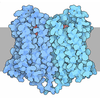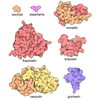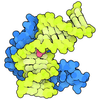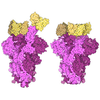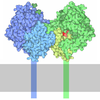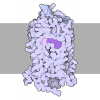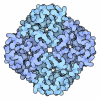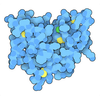[English] 日本語
 Yorodumi
Yorodumi- PDB-9v2n: Macimorelin bound growth hormone secretagogue receptor in complex... -
+ Open data
Open data
- Basic information
Basic information
| Entry | Database: PDB / ID: 9v2n | ||||||||||||
|---|---|---|---|---|---|---|---|---|---|---|---|---|---|
| Title | Macimorelin bound growth hormone secretagogue receptor in complex with Gq | ||||||||||||
 Components Components |
| ||||||||||||
 Keywords Keywords | MEMBRANE PROTEIN/IMMUNE SYSTEM / Macimorelin / growth hormone secretagogue receptor / GHSR / GPCR / MEMBRANE PROTEIN-IMMUNE SYSTEM complex | ||||||||||||
| Function / homology |  Function and homology information Function and homology informationgrowth hormone secretagogue receptor activity / regulation of hindgut contraction / regulation of growth hormone secretion / positive regulation of small intestinal transit / negative regulation of locomotion involved in locomotory behavior / growth hormone-releasing hormone receptor activity / regulation of gastric motility / response to follicle-stimulating hormone / regulation of transmission of nerve impulse / ghrelin secretion ...growth hormone secretagogue receptor activity / regulation of hindgut contraction / regulation of growth hormone secretion / positive regulation of small intestinal transit / negative regulation of locomotion involved in locomotory behavior / growth hormone-releasing hormone receptor activity / regulation of gastric motility / response to follicle-stimulating hormone / regulation of transmission of nerve impulse / ghrelin secretion / positive regulation of appetite / growth hormone secretion / negative regulation of norepinephrine secretion / positive regulation of small intestine smooth muscle contraction / negative regulation of macrophage apoptotic process / positive regulation of eating behavior / adult feeding behavior / negative regulation of appetite / actin polymerization or depolymerization / positive regulation of multicellular organism growth / cellular response to thyroid hormone stimulus / response to growth hormone / regulation of postsynapse organization / positive regulation of insulin-like growth factor receptor signaling pathway / response to L-glutamate / positive regulation of vascular endothelial cell proliferation / negative regulation of interleukin-1 beta production / response to food / positive regulation of fatty acid metabolic process / response to dexamethasone / cellular response to insulin-like growth factor stimulus / regulation of synapse assembly / positive regulation of sprouting angiogenesis / regulation of neurotransmitter receptor localization to postsynaptic specialization membrane / decidualization / peptide hormone binding / negative regulation of interleukin-6 production / negative regulation of tumor necrosis factor production / postsynaptic modulation of chemical synaptic transmission / response to hormone / hormone-mediated signaling pathway / insulin-like growth factor receptor signaling pathway / synaptic membrane / Peptide ligand-binding receptors / negative regulation of insulin secretion / electron transport chain / G protein-coupled receptor activity / negative regulation of inflammatory response / Schaffer collateral - CA1 synapse / Olfactory Signaling Pathway / Activation of the phototransduction cascade / cellular response to insulin stimulus / G beta:gamma signalling through PLC beta / Presynaptic function of Kainate receptors / Thromboxane signalling through TP receptor / G protein-coupled acetylcholine receptor signaling pathway / Activation of G protein gated Potassium channels / Inhibition of voltage gated Ca2+ channels via Gbeta/gamma subunits / G-protein activation / Prostacyclin signalling through prostacyclin receptor / G beta:gamma signalling through CDC42 / Glucagon signaling in metabolic regulation / G beta:gamma signalling through BTK / Synthesis, secretion, and inactivation of Glucagon-like Peptide-1 (GLP-1) / ADP signalling through P2Y purinoceptor 12 / photoreceptor disc membrane / Sensory perception of sweet, bitter, and umami (glutamate) taste / Glucagon-type ligand receptors / Adrenaline,noradrenaline inhibits insulin secretion / Vasopressin regulates renal water homeostasis via Aquaporins / Glucagon-like Peptide-1 (GLP1) regulates insulin secretion / G alpha (z) signalling events / cellular response to catecholamine stimulus / ADORA2B mediated anti-inflammatory cytokines production / ADP signalling through P2Y purinoceptor 1 / G beta:gamma signalling through PI3Kgamma / adenylate cyclase-activating dopamine receptor signaling pathway / Cooperation of PDCL (PhLP1) and TRiC/CCT in G-protein beta folding / response to estradiol / GPER1 signaling / Inactivation, recovery and regulation of the phototransduction cascade / cellular response to prostaglandin E stimulus / G-protein beta-subunit binding / heterotrimeric G-protein complex / G alpha (12/13) signalling events / sensory perception of taste / extracellular vesicle / signaling receptor complex adaptor activity / Thrombin signalling through proteinase activated receptors (PARs) / retina development in camera-type eye / cellular response to lipopolysaccharide / GTPase binding / Ca2+ pathway / fibroblast proliferation / High laminar flow shear stress activates signaling by PIEZO1 and PECAM1:CDH5:KDR in endothelial cells / spermatogenesis / G alpha (i) signalling events / G alpha (s) signalling events / phospholipase C-activating G protein-coupled receptor signaling pathway / G alpha (q) signalling events Similarity search - Function | ||||||||||||
| Biological species |  Homo sapiens (human) Homo sapiens (human)   | ||||||||||||
| Method | ELECTRON MICROSCOPY / single particle reconstruction / cryo EM / Resolution: 2.63 Å | ||||||||||||
 Authors Authors | Wang, R. / Sun, J. / Liu, H. / Guo, S. / Zhang, Y. / Hu, W. / Wang, J. / Liu, H. / Zhuang, Y. / Jiang, Y. ...Wang, R. / Sun, J. / Liu, H. / Guo, S. / Zhang, Y. / Hu, W. / Wang, J. / Liu, H. / Zhuang, Y. / Jiang, Y. / Xie, X. / Xu, H. / Wang, Y. | ||||||||||||
| Funding support |  China, 3items China, 3items
| ||||||||||||
 Citation Citation |  Journal: Acta Pharmacol Sin / Year: 2025 Journal: Acta Pharmacol Sin / Year: 2025Title: Molecular recognition of two approved drugs Macimorelin and Anamorelin by the growth hormone secretagogue receptor. Authors: Ruo-Lan Wang / Jun Sun / Heng Liu / Shi-Meng Guo / Yu Zhang / Wen Hu / Jiang Wang / Hong Liu / You-Wen Zhuang / Yi Jiang / Xin Xie / H Eric Xu / Yue Wang /  Abstract: The growth hormone secretagogue receptor (GHSR) plays a critical role in regulating growth hormone release and metabolic homeostasis. Understanding the molecular mechanisms of ligand-GHSR recognition ...The growth hormone secretagogue receptor (GHSR) plays a critical role in regulating growth hormone release and metabolic homeostasis. Understanding the molecular mechanisms of ligand-GHSR recognition is essential for developing therapeutic interventions. In this study, we investigated the molecular recognition mechanisms of two clinically approved drugs: Macimorelin (used for diagnosing adult growth hormone deficiency) and Anamorelin (approved in Japan for cancer cachexia). Using high-resolution cryo-electron microscopy, we determined the structures of GHSR bound to Macimorelin and Anamorelin in complex with G proteins at resolutions of 2.63 Å and 2.52 Å, respectively. We revealed that both drugs occupied a bifurcated binding pocket divided by a conserved salt bridge between E124 and R283. Through systematic mutagenesis and functional studies, we identified the key residues underlying the higher binding affinity of Anamorelin compared to Macimorelin. In addition, structural comparison of GHSR in complex with different G protein subtypes elucidated the mechanisms driving G protein selectivity. Our results provide crucial insights into GHSR-drug interactions and offer valuable guidance for designing more selective and potent GHSR agonists. | ||||||||||||
| History |
|
- Structure visualization
Structure visualization
| Structure viewer | Molecule:  Molmil Molmil Jmol/JSmol Jmol/JSmol |
|---|
- Downloads & links
Downloads & links
- Download
Download
| PDBx/mmCIF format |  9v2n.cif.gz 9v2n.cif.gz | 303.7 KB | Display |  PDBx/mmCIF format PDBx/mmCIF format |
|---|---|---|---|---|
| PDB format |  pdb9v2n.ent.gz pdb9v2n.ent.gz | Display |  PDB format PDB format | |
| PDBx/mmJSON format |  9v2n.json.gz 9v2n.json.gz | Tree view |  PDBx/mmJSON format PDBx/mmJSON format | |
| Others |  Other downloads Other downloads |
-Validation report
| Arichive directory |  https://data.pdbj.org/pub/pdb/validation_reports/v2/9v2n https://data.pdbj.org/pub/pdb/validation_reports/v2/9v2n ftp://data.pdbj.org/pub/pdb/validation_reports/v2/9v2n ftp://data.pdbj.org/pub/pdb/validation_reports/v2/9v2n | HTTPS FTP |
|---|
-Related structure data
| Related structure data |  64734MC  9uy3C M: map data used to model this data C: citing same article ( |
|---|---|
| Similar structure data | Similarity search - Function & homology  F&H Search F&H Search |
- Links
Links
- Assembly
Assembly
| Deposited unit | 
|
|---|---|
| 1 |
|
- Components
Components
-Protein , 2 types, 2 molecules AR
| #1: Protein | Mass: 41855.578 Da / Num. of mol.: 1 Source method: isolated from a genetically manipulated source Source: (gene. exp.)  Homo sapiens (human) / Production host: Homo sapiens (human) / Production host:  |
|---|---|
| #5: Protein | Mass: 76149.734 Da / Num. of mol.: 1 Source method: isolated from a genetically manipulated source Source: (gene. exp.)   Homo sapiens (human) Homo sapiens (human)Gene: cybC, GHSR / Production host:  |
-Guanine nucleotide-binding protein ... , 2 types, 2 molecules BG
| #2: Protein | Mass: 40226.992 Da / Num. of mol.: 1 Source method: isolated from a genetically manipulated source Source: (gene. exp.)  Homo sapiens (human) / Gene: GNB1 / Production host: Homo sapiens (human) / Gene: GNB1 / Production host:  |
|---|---|
| #3: Protein | Mass: 7861.143 Da / Num. of mol.: 1 Source method: isolated from a genetically manipulated source Source: (gene. exp.)  Homo sapiens (human) / Gene: GNG2 / Production host: Homo sapiens (human) / Gene: GNG2 / Production host:  |
-Antibody , 2 types, 2 molecules NS
| #4: Antibody | Mass: 15343.019 Da / Num. of mol.: 1 Source method: isolated from a genetically manipulated source Source: (gene. exp.)   Escherichia phage EcSzw-2 (virus) Escherichia phage EcSzw-2 (virus) |
|---|---|
| #6: Antibody | Mass: 32561.281 Da / Num. of mol.: 1 Source method: isolated from a genetically manipulated source Source: (gene. exp.)   |
-Non-polymers , 1 types, 1 molecules
| #7: Chemical | ChemComp-A1EQV / Mass: 474.555 Da / Num. of mol.: 1 / Source method: obtained synthetically / Formula: C26H30N6O3 / Feature type: SUBJECT OF INVESTIGATION |
|---|
-Details
| Has ligand of interest | Y |
|---|---|
| Has protein modification | N |
-Experimental details
-Experiment
| Experiment | Method: ELECTRON MICROSCOPY |
|---|---|
| EM experiment | Aggregation state: PARTICLE / 3D reconstruction method: single particle reconstruction |
- Sample preparation
Sample preparation
| Component | Name: Macimorelin bound growth hormone secretagogue receptor in complex with Gq Type: COMPLEX / Entity ID: #1-#6 / Source: MULTIPLE SOURCES |
|---|---|
| Source (natural) | Organism:  Homo sapiens (human) Homo sapiens (human) |
| Source (recombinant) | Organism:  |
| Buffer solution | pH: 7.3 |
| Specimen | Embedding applied: NO / Shadowing applied: NO / Staining applied: NO / Vitrification applied: YES |
| Vitrification | Cryogen name: ETHANE |
- Electron microscopy imaging
Electron microscopy imaging
| Experimental equipment | 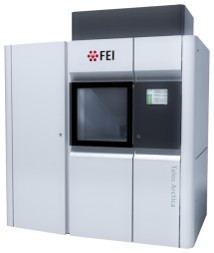 Model: Talos Arctica / Image courtesy: FEI Company |
|---|---|
| Microscopy | Model: FEI TALOS ARCTICA |
| Electron gun | Electron source: OTHER / Accelerating voltage: 300 kV / Illumination mode: OTHER |
| Electron lens | Mode: OTHER / Nominal defocus max: 2000 nm / Nominal defocus min: 1000 nm |
| Image recording | Electron dose: 50 e/Å2 / Film or detector model: FEI FALCON IV (4k x 4k) |
- Processing
Processing
| EM software | Name: PHENIX / Version: 1.20.1_4487 / Category: model refinement | ||||||||||||||||||||||||
|---|---|---|---|---|---|---|---|---|---|---|---|---|---|---|---|---|---|---|---|---|---|---|---|---|---|
| CTF correction | Type: PHASE FLIPPING AND AMPLITUDE CORRECTION | ||||||||||||||||||||||||
| 3D reconstruction | Resolution: 2.63 Å / Resolution method: FSC 0.143 CUT-OFF / Num. of particles: 146801 / Symmetry type: POINT | ||||||||||||||||||||||||
| Refinement | Highest resolution: 2.63 Å Stereochemistry target values: REAL-SPACE (WEIGHTED MAP SUM AT ATOM CENTERS) | ||||||||||||||||||||||||
| Refine LS restraints |
|
 Movie
Movie Controller
Controller



 PDBj
PDBj
